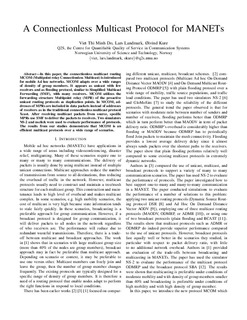| dc.contributor.author | Thi Minh Do, Viet | |
| dc.contributor.author | Landmark, Lars | |
| dc.contributor.author | Kure, Øivind | |
| dc.date.accessioned | 2016-04-08T12:44:54Z | |
| dc.date.accessioned | 2016-04-27T09:19:49Z | |
| dc.date.available | 2016-04-08T12:44:54Z | |
| dc.date.available | 2016-04-27T09:19:49Z | |
| dc.date.issued | 2012 | |
| dc.identifier.citation | Heraklion, Greece [Eds.] 2012 International Conference on Telecommunications and Multimedia (TEMU) p. 135-141, IEEE Communications Society, 2012 | nb_NO |
| dc.identifier.isbn | 978-1-4673-2781-7 | |
| dc.identifier.uri | http://hdl.handle.net/11250/2387562 | |
| dc.description.abstract | In this paper, the connectionless multicast routing MCOM (Multipoint relay Connectionless Multicast) is introduced for mobile Ad hoc networks. MCOM adapts over a wide ranges of density of group members. It appears as unicast with few receivers and as flooding protocol, similar to Simplified Multicast Forwarding (SMF), with many receivers. MCOM utilizes the forwarding structure Multipoint relay (MPR) of the proactive unicast routing protocols as duplication points. In MCOM, addresses of MPRs are included in data packets instead of addresses of receivers as in the traditional connectionless multicast protocol Xcast. After receiving multicast packets from source, specific MPRs use SMF to deliver the packets to receivers. Two simulators NS-2 and nsclick were used to evaluate performance of protocols. The results from our studies demonstrate that MCOM is an efficient multicast protocols over a wide range of scenarios. | nb_NO |
| dc.language.iso | eng | nb_NO |
| dc.publisher | IEEE Communications Society | nb_NO |
| dc.relation.ispartofseries | 2012 International Conference on Telecommunications and Multimedia (TEMU); | |
| dc.relation.uri | http://ieeexplore.ieee.org/xpl/articleDetails.jsp?reload=true&arnumber=6294704 | |
| dc.title | A connectionless multicast protocol for MANETs | nb_NO |
| dc.type | Chapter | nb_NO |
| dc.date.updated | 2016-04-08T12:44:54Z | |
| dc.description.version | acceptedVersion | |
| dc.identifier.doi | 10.1109/TEMU.2012.6294704 | |
| dc.identifier.cristin | 1197151 | |
| dc.description.localcode | (c) 2012 IEEE. Personal use of this material is permitted. Permission from IEEE must be obtained for all other users, including reprinting/ republishing this material for advertising or promotional purposes, creating new collective works for resale or redistribution to servers or lists, or reuse of any copyrighted components of this work in other works. | nb_NO |
